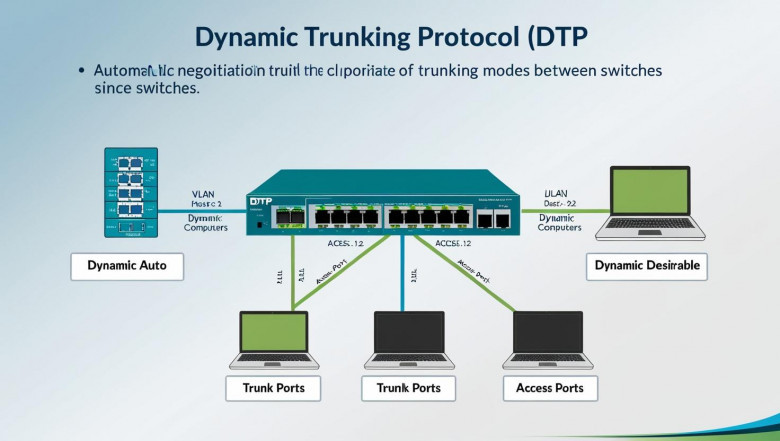views
Dynamic Trunking Protocol: A Fundamental Subject in All CCNA and CISSP Courses
With the dynamic nature of the network and security world, it is important to learn basic protocols. One of these protocols, the Dynamic Trunking Protocol (DTP), is crucial when dealing with VLAN configurations within enterprise networks today. Regardless of whether you're taking an online CCNA course or an advanced CISSP course, learning DTP is important for your success.
At UniNets, we focus on practical applications of the technologies such as DTP with major networking fundamentals such as the TCP header format, BGP interview questions, etc. This tutorial covers what is DTP, how it functions, and why it is an important topic in both CCNA and CISSP certification routes.

What Is Dynamic Trunking Protocol (DTP)?
Dynamic Trunking Protocol (DTP) is an industry-leading Cisco proprietary protocol to automatically negotiate the trunk links between Cisco network switches. Trunking supports carrying multiple VLANs on a single physical link, making VLAN deployment scalable and efficient.
In simpler words, DTP assists switches in determining whether to establish a trunk port (to transport multiple VLANs) or just be an access port (transporting one VLAN). Network administrators would have to configure trunk links manually between each pair of switches without DTP.
How Does DTP Work?
DTP works at Layer 2 (Data Link Layer) of the OSI model and only on devices connected directly to Cisco equipment or equivalent devices.
There are a number of DTP port modes:
Dynamic Auto – Awaits to hear DTP messages to become a trunk.
Dynamic Desirable – Actively tries to establish a trunk link.
Trunk – Forcing the port into trunk mode.
Access – Forcing the port into access mode.
Nonegotiate – Suppressing DTP messages (used with manual trunk setups).
When two switches are being connected:
If one is Dynamic Desirable and the other is Dynamic Auto, they will effectively create a trunk.
If both of them are configured to Dynamic Auto, no trunk is created.
Why Is DTP Essential in the CCNA Course Online?
In the CCNA course online provided by UniNets, Dynamic Trunking Protocol is a critical part of the switching course. It's especially applicable in labs that have:
VLAN configuration
Inter-switch communication
Automation of the network
You'll find out how to configure DTP through CLI (Command-Line Interface), the negotiation process of DTP, and diagnosing problems occurring due to DTP mismatches.
This will negotiate an active trunk link. Hands-on practices in UniNets labs will provide you with hands-on experience on similar commands in real time.
Why DTP is Important in CISSP Course
For CISSP students, security implications of DTP are the focus. Although DTP makes trunk creation easier, it also carries security risks, particularly when configured enabled on non-used or misconfigured ports.
Security Risks with DTP:
VLAN Hopping Attacks – Attackers use DTP to negotiate a trunk and gain access to several VLANs.
Unauthorized Access – Switch ports without security, when in dynamic mode, can be utilized to form rogue trunk links.
Best Practices:
disable DTP on all non-trunk ports with switchport nonegotiate
Set unused ports to access mode and shutdown
Utilize VLAN Access Control Lists (VACLs)
Understanding these threats and how to avoid them is essential in protecting enterprise network infrastructure in the CISSP course.
Relation to TCP Header Format and Network Layers
Though DTP operates at Layer 2, a proper networking education involves an understanding of how communication takes place at the upper layers. This is where the format of the TCP header becomes relevant.
TCP Header Format Essentials:
Source & Destination Port Numbers
Sequence & Acknowledgment Numbers
Control Flags (SYN, ACK, FIN)
Checksum
Window Size
The TCP header plays a critical role in providing reliable transmission in today's networks. It handles connection establishment, flow control, and data integrity—abilities you need in both CCNA and CISSP certifications.
Take the case where you are examining a BGP session. You'll discover that it utilizes TCP port 179. Knowledge of the TCP header will enable you to dissect such connections and fault-fix issues.
BGP Interview Questions and Their Relevance
DTP could be more focused in switching, but understanding allied protocols such as BGP (Border Gateway Protocol) is just as important if you have career development aspirations. In networking interviews, you could find typical BGP interview questions that test your skill to contrast Layer 2 and Layer 3 operations.
Example of BGP Interview Questions:
Q1: Why do we use TCP rather than UDP with BGP?
A1: BGP employs TCP for assured delivery since TCP offers error checking, flow control, and session establishment—capabilities lacking in UDP.
Q2: On which port does BGP operate?
A2: TCP port 179.
These interview questions directly relate back to your understanding of the TCP header format, and knowing DTP brings additional depth to your Layer 2 knowledge—giving you an edge at job interviews.
Dynamic Trunking Protocol at UniNets
At UniNets, our online CCNA course and CISSP course offer:
Comprehensive video lectures on DTP configuration and negotiation
Cisco Packet Tracer and actual switch hardware-based labs
Best practices for security when dealing with VLANs and trunk ports
Combining DTP labs with examination of the TCP header in real-time network traffic
Mock interview sessions on BGP interview questions and answers are also included to help you bridge technical knowledge and practical career skills.
Final Thoughts
The Dynamic Trunking Protocol (DTP) is not just a convenience option for switch setup—it's a fundamental aspect of network design and security. Whether it's setting up VLANs in a corporate LAN or preventing trunk-based security breaches, DTP is an essential part of your networking career.
Whether you are studying a CCNA course online or getting ready to take the CISSP course at UniNets, DTP is a protocol that you can't afford to miss. Combine your understanding of DTP with expertise in TCP header format and BGP interview questions, and you'll be well-equipped to become a well-rounded, job-ready network professional.



Comments
0 comment